10+ Sample Vehicle Safety Checklist
-
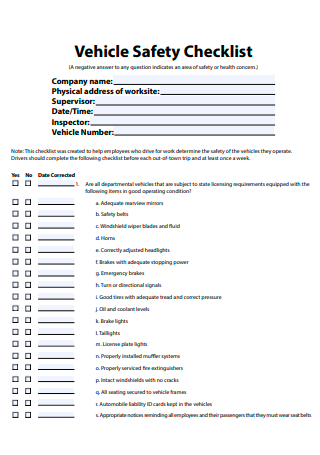
Vehicle Safety Checklist Template
download now -

Motor Vehicle Weekly Safety Checklist
download now -
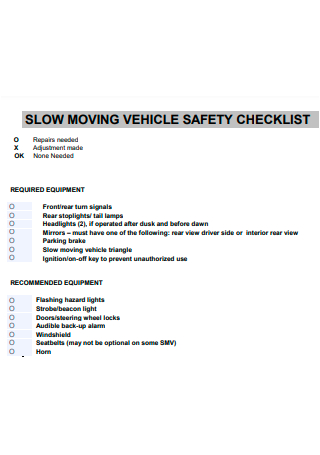
Slow Moving Vehicle Safety Checklist
download now -
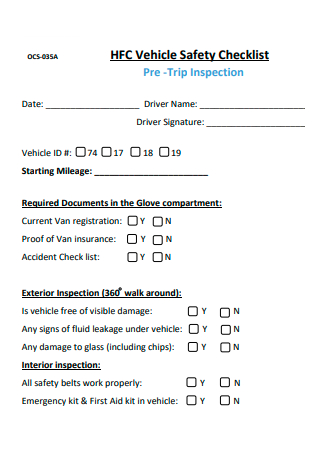
Basic Vehicle Safety Checklist
download now -

Motor Vehicle Safety Checklist Example
download now -

Service Vehicle Weekly Safety Inspection Checklist
download now -
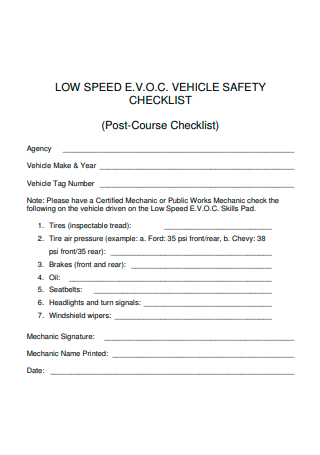
Low Speed Vehicle Safety Checklist
download now -

Vehicle Safety Inspection Checklist
download now -
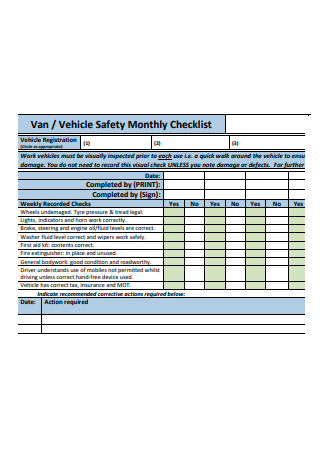
Vehicle Safety Monthly Checklist
download now -
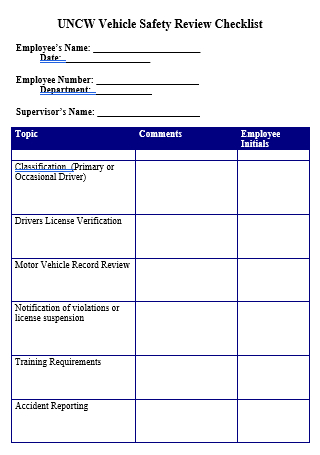
Vehicle Safety Review Checklist
download now -
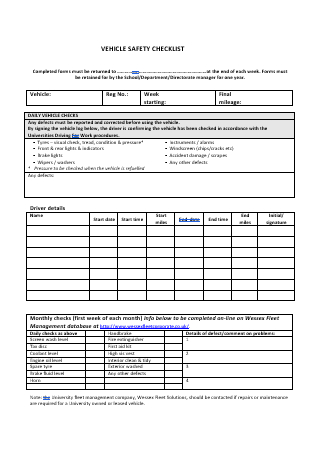
Vehicle Safety Checklist in DOC
download now
FREE Vehicle Safety Checklist s to Download
10+ Sample Vehicle Safety Checklist
What Is a Vehicle Safety Checklist?
Why Do You Need a Vehicle Safety Checklist?
The Must-Have Elements in a Vehicle Safety Checklist
How to Make a Well-Driven Vehicle Safety Checklist
FAQs
How are vehicle problems detected?
How much does a vehicle inspection cost?
What are the important vehicle details to document?
What Is a Vehicle Safety Checklist?
A vehicle safety checklist is basically like your daily vehicle inspection checklist. It is a document you use to inspect, maintain, and ensure that your automobile is in excellent condition; thus, safe for driving. And drivers must have their personal vehicle safety checklist to avoid accidents and anything that harms passengers or the car itself. Thanks to the checklist, all the tasks to ensure safety while driving are lined up so you won’t have to memorize the steps. Just follow the written instructions, put checkmarks on every item you finished, and you are guaranteed to succeed.
It was reported that about 1.24 million deaths came from road vehicle accidents per year worldwide.
Also, the National Safety Council confirmed that using cellphones upon driving led up to 1.6 million vehicle crashes each year.
Why Do You Need a Vehicle Safety Checklist?
A vehicle safety list or checklist might just be what saves your life from road traffic accidents; thus, making it very important. It is essential for prevention purposes. So instead of waiting for your car to break or cause any road danger, at least you can prevent those from happening due to the enlisted maintenance steps in the checklist. Any driver is guaranteed to operate the car properly and to protect passengers safely rather than being complacent that nothing bad happens with your ride. More so, you can save money fixing a tiny error on a car yourself instead of heading to an auto service right away.
Also, there is more to assuring safety while driving besides the basic rule of fastening your seatbelt. Without realizing it, you might encounter engine problems or misaligned mirrors. And to ensure you won’t forget the necessary steps to accomplish, vehicle safety checklists have everything so memorizing is unnecessary. Also, a vehicle checklist is useful for any driver, not just for personal use. It can be used to maintain trucks in shipping or trucking industries, for example. And you won’t have to finish all tasks daily because there are weekly, monthly, and quarterly tasks too.
The Must-Have Elements in a Vehicle Safety Checklist
Indeed, a vehicle safety checklist is important. But have you ever wondered what makes up a standard vehicle safety checklist? For sure, it contains a list and some checkboxes to insert marks on. But what about the specific items to maintain automobiles? In this section, you will learn about the must-have elements to add to your vehicle safety checklist.
How to Make a Well-Driven Vehicle Safety Checklist
After taking an insightful road trip from the vehicle safety checklist’s definition, its importance, down to its essential elements, are you ready to create a vehicle safety checklist yourself? And is your answer yes but not sure where to start? Rest assured, your ideas won’t run out of gas when you follow these steps of how to formulate well-driven vehicle safety checklists seamlessly:
Step 1: Inspect Your Ride and Review Your Vehicle Manual
First of all, all types of vehicles don’t use the same vehicle safety checklist, especially when some automobiles differ in size, model, brand, color, purpose, and other variations. So the key is to familiarize your ride’s features first so you can figure out the appropriate safety measures to deal with your car. Expect to use your vehicle manual to review the car features and other instructions worth adding to the checklist. You can also research how top-quality vehicle safety measures are managed online, like from checklists approved by the Occupational Safety and Health Standards Act or OSHA.
Step 2: Pick a Sample Vehicle Safety Checklist Template
Now that you have enough knowledge about your ride and what appropriate form of measures to add to the checklist, start drafting your ideas in a sample template. See those sample vehicle safety checklists above this article? Those are your template options. Just choose your favorite template and you can create the vehicle safety checklist pronto. And the best part is you can create alterations. Be sure to insert the appropriate maintenance measures for your vehicle and that you take advantage of the sample’s customizable features.
Step 3: Label Your Checklist Accordingly
Don’t forget to begin labeling. Just like most checklists, you begin with the title—using “Vehicle Safety Checklist” as your title already works. Then, create categories arranged in a format that is most fitting to you. You could make a table wherein columns are divided according to the itemized checkbox list, the task list, the progress tracker, and notes. Another example is to lessen the need to write complete sentences so you can use sketches, organizational charts, graphs, and more. But, make sure your checklist is still easy to follow after labeling everything.
Step 4: Set and Organize a Task List
In adding data to your itemized task list, make sure it covers the must-have elements as well. As discussed earlier, there are standard elements in vehicle safety checklists. Those are the tires, lights and signals, down to the no cellphone while driving policy. And you can also add more elements that are needed to maintain your car and improve safety while driving. Also, be careful with what instructions you add because if observing the checklist is hard to follow, then don’t expect to finish your vehicle safety checklist’s tasks smoothly.
Step 5: Assign a Schedule to the Itemized List of Tasks
A vehicle safety checklist is more effective when it includes a scheduled list of activities rather than just a standard task checklist. Scheduling is crucial so that you become sure of when to commit to the checklist rather than just committing to it whenever you are in the mood to maintain your car. That explains why there is a monthly or weekly vehicle maintenance checklist template, for example. You don’t have to do all tasks every single day.
Step 6: Know Your Audience
In writing the vehicle safety checklist’s content, be sure you know your audience really well. If that checklist is meant for you to use, then there is freedom with its layout, wording, and more. But if you are making that checklist for an employee, a friend, or a student, then that tells you to be careful with your words, format, and other details. Ensure that the language you use is understandable to your target audience and that its design or structure is something they prefer too.
Step 7: Be Straightforward but Keep Enough Detail
The checklist should be short but not to the point where it lacks the important details. At the same time, don’t keep it too detailed as if you are writing an entire vehicle inspection report yet you are missing the whole point. The key is to balance it out by being straightforward but still keeping the significant parts. So after writing everything down, take a look back at what you wrote. There might be some edits needed so rectify them until you are glad about the outcome.
Step 8: Depend on Your Vehicle Safety Checklist Regularly
When you’re through with the road in making the checklist, the job doesn’t end there. Expect to drive continuously by depending on your checklist regularly. You can only expect your vehicle to be well-maintained if you have followed the steps written in the vehicle safety checklist as planned anyway. But when the worst scenarios happen, particularly if the car still has issues after maintaining it yourself, that is the time to call for professional auto service. Also, check your auto contract if there are free inspection services or discounted maintenance rates in case you missed those.
FAQs
How are vehicle problems detected?
The Federal Trade Commission (FTC) reported that you can always detect the notable signs of vehicular issues through your senses. This includes viewing all parts of your car, listening to any odd noise, sensing strange odors, and feeling a vast difference from how your car worked before and as of the moment. And for more specific steps in detecting, you depend on a vehicle to-do list or checklist.
How much does a vehicle inspection cost?
Costs involving vehicle inspections may vary per business. But notably, most vehicle inspections cost around $150 to $250. So if you wish to save your budget from costly inspection services, learn how to maintain your own car with a checklist as your guide instead.
What are the important vehicle details to document?
There are lots of possible details about your ride that might be considered in conducting maintenance, inspection, and other services. And some of the significant vehicle details worth documenting are the vehicle type, vehicle model, license plate number, year the vehicle was made, and mileage.
Various countries have their own set of regulations regarding vehicle inspections. And if your car passes the quality paradigm, it doesn’t mean your automobile stays that way for how many weeks without monitoring its condition. Always use a vehicle safety checklist to protect your car, passengers, and yourself at all costs. Just as the Dutch philosopher Desiderius Erasmus’s saying goes, “Prevention is better than cure.” So before you set off to drive, always buckle up with sample vehicle safety checklists. Download now!
